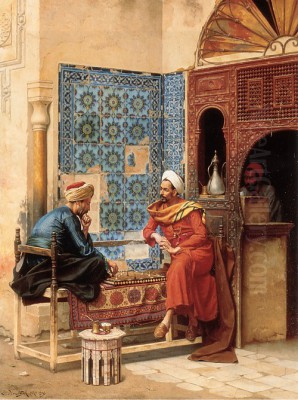
Ludwig Deutsch stands as one of the most accomplished and recognized figures within the Orientalist movement of the late 19th and early 20th centuries. An Austrian painter who found his greatest success in Paris, Deutsch built a remarkable career on his meticulously detailed and vividly realized depictions of life in the Middle East, particularly Egypt. His work combines the rigorous technique of European academic training with a fascination for the exotic, resulting in paintings that are both technically brilliant and culturally evocative, offering a specific, albeit European, window onto the world he observed.
Early Life and Artistic Formation in Vienna
Ludwig Deutsch was born in Vienna in 1855 into a prosperous and well-established Jewish family. His father, Ignaz Deutsch, was a respected financier at the Austrian court, suggesting an environment of culture and means that likely supported his artistic inclinations. Vienna, during Deutsch's formative years, was a vibrant imperial capital, a hub of artistic and intellectual activity, though perhaps still operating in the shadow of Paris as the ultimate center of the art world. The city's own artistic milieu, dominated by figures like the historical painter Hans Makart, fostered a rich environment, though Deutsch would eventually gravitate towards a different path.
His formal artistic education began at the prestigious Vienna Academy of Fine Arts (Akademie der bildenden Künste Wien) around 1872. There, he studied under the tutelage of Anselm Feuerbach, a prominent painter associated with German Neoclassicism and Romanticism. Feuerbach's emphasis on classical composition and historical themes likely provided Deutsch with a solid foundation in drawing and painting techniques. However, Feuerbach's tenure at the Academy was relatively short, ending with his resignation and subsequent death in 1880 (though Deutsch's direct study under him likely concluded by 1875).
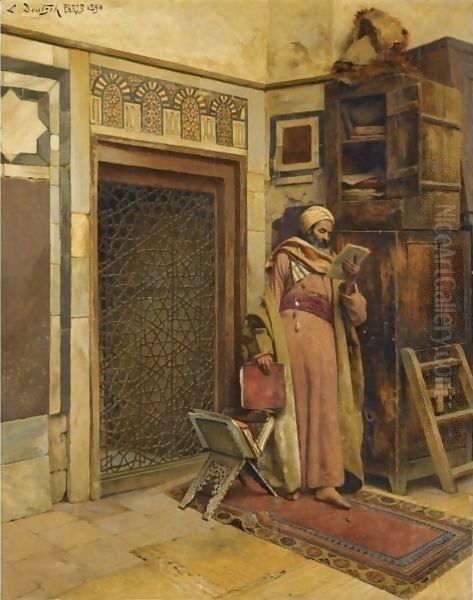
Following his time with Feuerbach, Deutsch sought further instruction. He reportedly attempted to join the studio of Leopold Carl Müller, another significant Austrian painter who was already making a name for himself with Orientalist subjects gleaned from his own travels to Egypt. While this initial connection might not have resulted in formal tutelage at that moment in Vienna, Müller's influence, and the broader European fascination with the "Orient," clearly resonated with the young Deutsch. This period marked his initial exposure to the themes that would come to define his career.
The Parisian Ascent and the Embrace of Orientalism
In 1878, seeking broader opportunities and immersion in the heart of the contemporary art world, Ludwig Deutsch made the pivotal decision to move to Paris. This relocation proved definitive for his career trajectory. Paris was unequivocally the global center for art, hosting the influential annual Salons and attracting artists from across Europe and America. It was also the epicenter of the Orientalist movement, a genre that captivated artists and audiences alike with its depictions of North Africa, the Middle East, and the Ottoman Empire.
Upon arriving in Paris, Deutsch reconnected with Leopold Carl Müller, who also spent time working in the French capital. He may have received further guidance from Müller, whose established reputation in Orientalist painting would have been invaluable. Paris provided Deutsch with exposure to the leading proponents of the genre. He would have undoubtedly studied the works of Jean-Léon Gérôme, arguably the most famous and commercially successful Orientalist painter of the era, known for his highly polished, almost photographic realism and dramatic historical or genre scenes.
Deutsch quickly established himself within the Parisian art community. He opened his own studio around 1880, likely located near the Parc Monceau, an area popular with artists. It was here that he began to seriously develop his Orientalist repertoire. Although his first documented travels to Egypt would occur slightly later, he produced his initial works in the genre as early as 1881, possibly working from photographs, studio props, and the accounts of other artists, a common practice among Orientalist painters, including Gérôme himself. Paris offered a wealth of resources, from collections of Islamic art and artifacts to photographic studios specializing in Middle Eastern subjects.
Travels to the East: Inspiration and Observation
While studio work and secondary sources were crucial, direct experience of the regions he depicted became increasingly important for Deutsch's artistic practice, lending authenticity and specificity to his canvases. His first documented journey to Egypt is believed to have taken place around 1885, followed by subsequent trips in 1890 and 1898. There may have been other undocumented visits as well; some sources suggest he traveled to Egypt at least five times throughout his career.

These voyages were fundamental. They allowed Deutsch to gather firsthand impressions, sketch local people and architecture, study the quality of light unique to the region, and acquire a vast collection of objects. He brought back textiles, furniture, ceramics, metalwork, musical instruments, and traditional clothing. These items filled his Paris studio, transforming it into a repository of Middle Eastern material culture that served as authentic props for his paintings. This practice was shared by many Orientalists, including his friend and fellow painter Rudolf Ernst, whose studio was similarly filled with exotic artifacts.
Deutsch also embraced photography as a vital tool, much like Gérôme and other contemporaries such as the American Orientalist Frederick Arthur Bridgman. He collected photographs taken by commercial studios operating in Egypt, such as the Abdullah Frères or Hippolyte Arnoux, and likely took his own photographs during his travels. These images served as invaluable references for architectural details, costumes, and even figural poses, contributing to the remarkable precision and realism that characterize his work. However, Deutsch never merely copied photographs; he synthesized these visual notes with his sketches and collected objects to create carefully composed, idealized scenes.
Artistic Style: Realism, Detail, and Light
Ludwig Deutsch's artistic style is defined by its meticulous realism, extraordinary attention to detail, and masterful handling of light and texture. He worked primarily in oil on panel or canvas, employing traditional academic techniques learned in Vienna and refined in Paris. His approach aligns closely with the highly finished style favored by academic painters like Gérôme, but Deutsch often pushed the level of detail to an almost hyperrealistic degree.
His rendering of surfaces is particularly noteworthy. Intricate tilework patterns, the complex inlay of mother-of-pearl on furniture, the rich sheen of silk robes, the rough texture of stone walls, and the gleam of polished metal are all depicted with astonishing fidelity. This fascination with texture and pattern connects him to other Austrian artists with a penchant for decorative detail, though his subject matter differed significantly from, say, the later works of Gustav Klimt. Deutsch used fine brushes and careful layering of paint to achieve these effects, creating surfaces that invite close inspection.
The treatment of light is another hallmark of his style. Whether depicting sun-drenched exteriors or the cool, filtered light of palace interiors, Deutsch demonstrated a sophisticated understanding of chiaroscuro. He used light not only to model form and create a sense of three-dimensionality but also to enhance the mood and focus the viewer's attention. Highlights gleam off polished surfaces, while deep shadows add mystery and depth. This careful orchestration of light contributes significantly to the convincing atmosphere of his scenes.
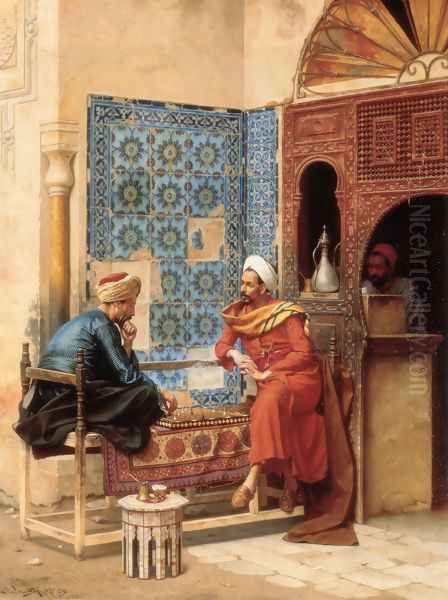
Compared to the earlier, more Romantic Orientalism of Eugène Delacroix or Eugène Fromentin, Deutsch's work is less concerned with dramatic action or overt emotionalism. His paintings often depict quiet, contemplative moments – scholars reading, guards standing watch, men playing chess or listening to music. The figures are typically rendered with ethnographic precision in terms of costume and physiognomy, yet they often possess a certain stillness and psychological distance, becoming elements within a beautifully orchestrated tableau rather than protagonists in a narrative.
Iconic Themes and Subjects
Deutsch's oeuvre revolves around a consistent set of themes and subjects drawn from his observations and imagination of Egyptian life, particularly in Cairo. He rarely depicted the bustling, chaotic street scenes favored by some Orientalists. Instead, he focused on more controlled environments and specific character types, often presented as single figures or small groups.
Scholars and Scribes: Figures engaged in intellectual or religious study are a recurring motif. Paintings like The Scholar or scenes depicting men reading the Quran showcase Deutsch's interest in learning and contemplation within Islamic culture. These works often feature elaborate interiors filled with books, writing implements, and decorative objects, emphasizing the dignity and importance of knowledge.
Palace Guards and Sentinels: Perhaps his most famous subjects are the imposing figures of palace guards, often Nubian, dressed in elaborate uniforms and armed with traditional weapons. These figures, typically shown standing stoically at doorways or within ornate palace halls, convey a sense of authority, discipline, and exotic splendor. They allowed Deutsch to indulge his skill in rendering elaborate costumes and weaponry.
Musicians and Entertainers: Scenes involving music, such as The Oud Player, capture moments of leisure and cultural expression. These paintings often highlight the intricate details of musical instruments and the focused concentration of the performers.
Merchants and Craftsmen: While less common than his depictions of guards or scholars, Deutsch occasionally painted scenes featuring specific trades or street vendors, such as The Sahlab Vendor, Cairo. These works offer glimpses into the daily commerce and social fabric of the city, always rendered with his characteristic precision.
Religious Life: Prayer and religious observance feature prominently. Works like Morning Prayer or At Prayer depict men engaged in salah, often within architecturally detailed mosque interiors or courtyards. These scenes are treated with reverence and a focus on the spiritual atmosphere, conveyed through the careful use of light and space.
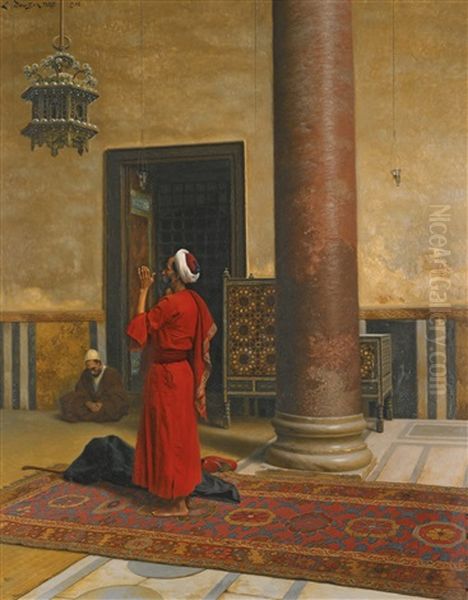
Architectural Settings: The settings themselves are often as important as the figures. Deutsch meticulously rendered the details of Mamluk and Ottoman-era architecture found in Cairo – intricate mashrabiya (wooden lattice screens), geometric tilework, carved stucco, and ornate doorways. These architectural elements provide a rich, authentic backdrop for his figures and contribute significantly to the overall effect of his paintings.
Masterworks: A Closer Look
Several paintings stand out as quintessential examples of Ludwig Deutsch's artistry and have become iconic representations of his work.
The Palace Guard (often dated 1896): This is arguably Deutsch's most celebrated painting. It depicts a formidable guard, likely Nubian, standing sentinel before an intricately decorated doorway. The level of detail in the guard's vibrant costume – the silk fabrics, the embroidered patterns, the gleaming metal accessories – is breathtaking. Equally impressive is the rendering of the architectural setting, with its complex tilework and carved details. The figure's stoic pose and direct gaze convey a powerful presence. The painting exemplifies Deutsch's ability to combine ethnographic detail with a sense of imposing grandeur.
The Chess Game (various versions exist, e.g., 1904): Scenes depicting men engrossed in a game of chess allowed Deutsch to explore social interaction in a quiet, contemplative setting. These works showcase his skill in composing multi-figure scenes, capturing subtle gestures and expressions. The rich interiors, often featuring inlaid furniture and luxurious textiles, provide a sumptuous backdrop for the intellectual contest. The play of light across the figures and the game board is typically handled with great finesse.
The Tribute (e.g., 1900): This painting, and similar works like The Treasury Chest, often depict scenes related to administration, wealth, or scholarly exchange. They might show officials receiving goods, scribes recording transactions, or scholars examining precious objects. These subjects provided ample opportunity for Deutsch to paint intricate details of coffers, textiles, documents, and decorative items, highlighting themes of power, knowledge, and commerce within the depicted society.
At Prayer (1923) / Morning Prayer (1902): These works capture moments of Islamic devotion with sensitivity and atmospheric depth. Deutsch focused on the postures of prayer, the serene expressions of the worshippers, and the interplay of light within sacred spaces. The architectural settings, whether mosque interiors or courtyards, are rendered with precision, enhancing the sense of reverence and tranquility. These paintings stand in contrast to the more martial or scholarly themes, showcasing another facet of the life he observed.

The Sahlab Vendor, Cairo (1886): This earlier work provides a glimpse into the everyday street life of Cairo. It depicts a vendor preparing sahlab, a traditional hot milk drink. The focus is on the vendor and his equipment, rendered with Deutsch's characteristic attention to detail. The painting offers a calmer, more intimate view of urban life compared to the grandeur of his palace scenes, demonstrating his versatility within the Orientalist genre.
Contemporaries and Context
Ludwig Deutsch operated within a thriving community of Orientalist painters in Paris. He maintained close friendships with several fellow artists who shared his interests, most notably Rudolf Ernst, another Austrian painter known for his highly detailed and jewel-like depictions of Islamic interiors and genre scenes. Arthur von Ferraris and Jean Discart were also part of this circle of Vienna-born artists working in Paris and specializing in Orientalist themes. Their shared background and artistic focus likely fostered a supportive, if perhaps subtly competitive, environment.
His work inevitably invites comparison with Jean-Léon Gérôme, the towering figure of French Orientalism. Both artists shared a commitment to academic finish, meticulous detail, and the use of photography. However, Deutsch's work often feels even more intensely focused on surface texture and decorative detail, sometimes at the expense of narrative dynamism. While Gérôme frequently depicted historical events or dramatic anecdotes, Deutsch favored more static, observational scenes.
Beyond his immediate circle, Deutsch's work can be situated within the broader European fascination with the East. British artists like John Frederick Lewis, known for his incredibly detailed watercolors and oils of Cairene interiors, pursued a similar path of immersive observation and detailed rendering, though often with a different sensibility regarding light and atmosphere. Earlier pioneers like David Roberts had documented the landscapes and monuments of the region, providing a foundation for later genre painters.
Within the Austrian context, Deutsch and his friend Ernst were among the leading Orientalists, alongside figures like Alphons Leopold Mielich and Charles Wilda. While Orientalism was perhaps less dominant in Vienna than in Paris, these artists contributed significantly to the genre from an Austrian perspective. It is also interesting to consider Deutsch's work in relation to non-European artists engaging with similar themes, such as the Ottoman painter Osman Hamdi Bey, who offered an insider's perspective on Ottoman life, often challenging Western stereotypes while employing a European academic style.
Recognition and Success
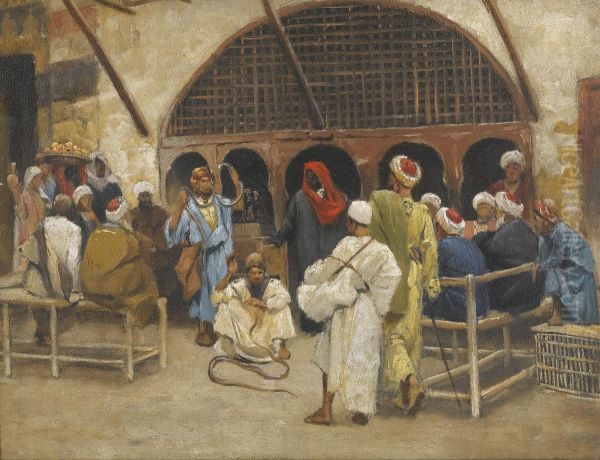
Ludwig Deutsch achieved considerable success and recognition during his lifetime. His paintings were regularly accepted into the prestigious Paris Salon, the main venue for artists to exhibit their work and gain patronage. His meticulous technique and appealing subject matter found favor with collectors in France, Britain, America, and Austria.
His reputation was solidified by official accolades. He received honorable mentions at the Salon and, significantly, was awarded a gold medal at the Exposition Universelle (World's Fair) held in Paris in 1900. This was a major international honor, confirming his status among the leading painters of his time. In the same year, his contributions to the arts were further recognized when he was named a Chevalier of the French Legion of Honour (Légion d'honneur), a prestigious civil merit award.
This success indicates that his vision of the Orient, characterized by technical brilliance, ethnographic detail, and a certain dignified exoticism, resonated strongly with contemporary tastes. He catered to a market eager for glimpses into faraway lands, presented with a reassuring level of academic polish and realism. His work avoided the overt sensuality or violence found in some Orientalist paintings, focusing instead on craftsmanship, contemplation, and orderly depictions of daily or ceremonial life.
Later Life and Legacy
Details about Ludwig Deutsch's later life are less abundant than those concerning his main period of activity. He continued to paint and exhibit, though the tide of artistic taste began to turn decisively in the early 20th century with the rise of Modernism. Fauvism, Cubism, and subsequent avant-garde movements challenged the very foundations of academic realism that Deutsch represented. Artists like Henri Matisse and Pablo Picasso, who were also influenced by non-Western art, explored it in radically different ways, prioritizing formal innovation over representational fidelity.
Despite the shifting art world, Deutsch seems to have remained committed to his established style. His later works, such as At Prayer (1923), show a continuation of his core themes and meticulous technique. He passed away in 1935, at the age of 80. By this time, the Orientalist genre, and academic painting in general, had largely fallen out of critical favor, overshadowed by the dramatic developments of modern art.
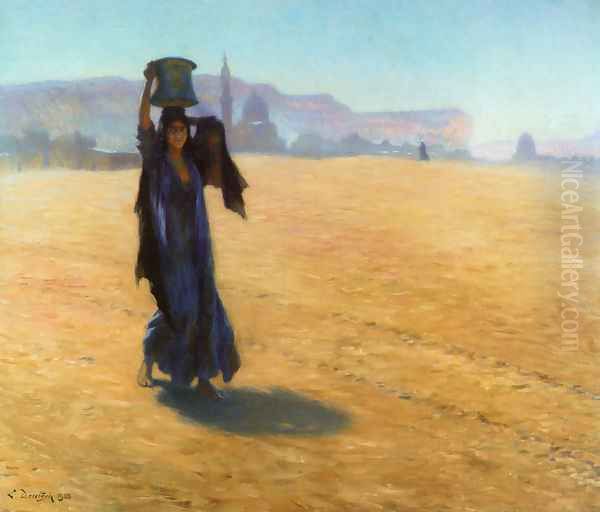
However, beginning in the later 20th century, there has been a significant reassessment and renewed appreciation for 19th-century academic art, including Orientalism. Ludwig Deutsch's work has experienced a resurgence of interest among collectors and art historians. His technical mastery is undeniable, and his paintings are valued as exquisite examples of a particular historical moment and artistic sensibility. His legacy lies in his contribution to the Orientalist genre, providing some of the most detailed and finely crafted visions of the Middle East produced by a European artist.
Deutsch in the Art Market
The renewed appreciation for Ludwig Deutsch's work is clearly reflected in his performance on the international art market. His paintings are highly sought after by collectors of 19th-century European art and Orientalism. Major auction houses like Christie's and Sotheby's regularly feature his works, often achieving strong prices.
The demand for his paintings is driven by several factors: their exceptional technical quality, the appealing and often tranquil subject matter, their relative rarity (he was a meticulous and therefore not overly prolific painter), and their historical significance within the Orientalist movement. His works are particularly prized for their decorative qualities and the sheer virtuosity of their execution.
A testament to his market strength came in 2019 when his masterpiece, The Palace Guard, sold at Christie's in London for a remarkable £4.3 million (approximately $5.4 million at the time), setting a new world auction record for the artist. Other significant works, such as The Tribute, The Offering, The Chess Game, and The Scholar, consistently command high six-figure and often seven-figure prices in US dollars or Euros when they appear at auction. This places Deutsch among the most commercially valued Orientalist painters, alongside Gérôme and Ernst. His works are held in private collections worldwide, as well as in institutions like the Shafik Gabr Collection in Zurich, which holds a significant number of his paintings.
Critical Reception and Art Historical Position
In art history, Ludwig Deutsch is firmly positioned as a leading figure of the second generation of Orientalist painters, active during the genre's peak popularity in the late 19th century. He is recognized primarily for his extraordinary technical skill, his ethnographic attention to detail (mediated through an academic lens), and his focus on specific aspects of Egyptian life, particularly Cairo.
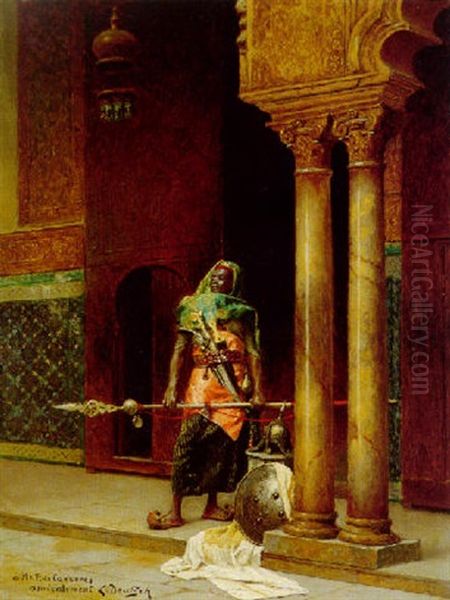
Academic evaluations praise his draftsmanship, his sophisticated use of color and light, and his unparalleled ability to render textures and intricate patterns. He is seen as a master technician who brought the precision of the Vienna Academy tradition to Parisian Orientalism. His use of photography and collected artifacts is acknowledged as integral to his method, contributing to the convincing realism of his work while also highlighting the constructed nature of Orientalist representation.
While celebrated for its technical brilliance, Deutsch's work, like all Orientalist art, is also subject to post-colonial critique. Orientalism as a genre is often analyzed for its tendency to exoticize, stereotype, or present a romanticized or patronizing view of non-European cultures, reflecting European colonial attitudes. Deutsch's paintings, with their focus on seemingly timeless traditions, opulent settings, and sometimes passive figures, can be interpreted within this framework. However, his work is generally seen as less prone to the overt eroticism or negative stereotyping found in some other Orientalist art. Many of his depictions emphasize dignity, scholarship, and cultural richness.
Ultimately, Ludwig Deutsch occupies a significant place in the history of 19th-century European art. He represents a specific strand of Orientalism characterized by meticulous realism, ethnographic detail, and a focus on quiet dignity rather than high drama. His paintings remain captivating for their technical virtuosity and their evocative, if idealized, portrayal of a world that fascinated European audiences.
Conclusion
Ludwig Deutsch forged a distinct and highly successful path within the vibrant art world of late 19th-century Paris. Building on his Austrian academic training, he embraced Orientalism, dedicating his career to depicting the people, architecture, and cultural life of Egypt with unparalleled precision and detail. Through his travels, his collection of artifacts, and his skillful use of photography and academic technique, he created a body of work that is both visually stunning and historically significant. While the broader context of Orientalism invites critical discussion, Deutsch's individual artistic achievement – his mastery of light, texture, and detail – remains undeniable. His paintings continue to command admiration and high prices, securing his legacy as a master of Orientalist art whose work offers a unique and meticulously crafted window onto a European vision of the East.